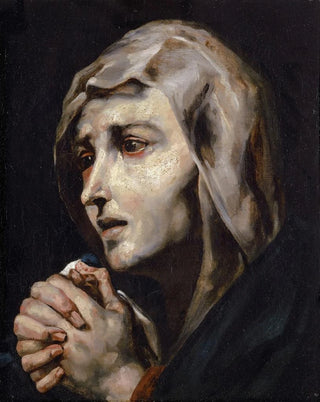Art print | Notre-Dame des Douleurs - Théodore Géricault


View from behind

Frame (optional)
In the tumultuous universe of early 19th-century art, one work stands out for its emotional intensity and symbolic depth: "Notre-Dame des Douleurs" by Théodore Géricault. This painting, which evokes suffering and compassion, is a true cry from the heart. Géricault, known for his bold approach and ability to capture the very essence of humanity, invites us to delve into a world where pain and beauty coexist. Contemplating this piece, the viewer is transported into a reflection on the human condition, on the fragility of existence, and on the power of empathy. The art print Notre-Dame des Douleurs - Théodore Géricault allows for appreciation of this masterpiece, while offering a new dimension to our living space.
Style and uniqueness of the work
"Notre-Dame des Douleurs" is characterized by a romantic style, where raw emotion is highlighted. Géricault uses dark colors and striking contrasts to create an atmosphere of melancholy and contemplation. The figures, marked by pain, are rendered with an almost sculptural precision, demonstrating the artist's technical mastery. Every detail, from the face etched with suffering to the gaunt posture of the bodies, contributes to a powerful visual narration. This painting does not merely depict a scene; it invites the viewer to feel, to understand, and to question the universal themes of suffering and redemption. Géricault, by capturing this essence, offers a work that transcends time and continues to touch souls.
The artist and his influence
Théodore Géricault, an emblematic figure of the Romantic movement, knew how to mark his era with an innovative approach. His career, though tragically cut short, left an indelible mark on the art world. Géricault drew inspiration from everyday life, human dramas, and historical events to fuel his creativity. His commitment to representing human suffering, as exemplified by "Notre-Dame des Douleurs," paved the way for many artists who followed. His influence extends well beyond his time

Matte finish

View from behind

Frame (optional)
In the tumultuous universe of early 19th-century art, one work stands out for its emotional intensity and symbolic depth: "Notre-Dame des Douleurs" by Théodore Géricault. This painting, which evokes suffering and compassion, is a true cry from the heart. Géricault, known for his bold approach and ability to capture the very essence of humanity, invites us to delve into a world where pain and beauty coexist. Contemplating this piece, the viewer is transported into a reflection on the human condition, on the fragility of existence, and on the power of empathy. The art print Notre-Dame des Douleurs - Théodore Géricault allows for appreciation of this masterpiece, while offering a new dimension to our living space.
Style and uniqueness of the work
"Notre-Dame des Douleurs" is characterized by a romantic style, where raw emotion is highlighted. Géricault uses dark colors and striking contrasts to create an atmosphere of melancholy and contemplation. The figures, marked by pain, are rendered with an almost sculptural precision, demonstrating the artist's technical mastery. Every detail, from the face etched with suffering to the gaunt posture of the bodies, contributes to a powerful visual narration. This painting does not merely depict a scene; it invites the viewer to feel, to understand, and to question the universal themes of suffering and redemption. Géricault, by capturing this essence, offers a work that transcends time and continues to touch souls.
The artist and his influence
Théodore Géricault, an emblematic figure of the Romantic movement, knew how to mark his era with an innovative approach. His career, though tragically cut short, left an indelible mark on the art world. Géricault drew inspiration from everyday life, human dramas, and historical events to fuel his creativity. His commitment to representing human suffering, as exemplified by "Notre-Dame des Douleurs," paved the way for many artists who followed. His influence extends well beyond his time






